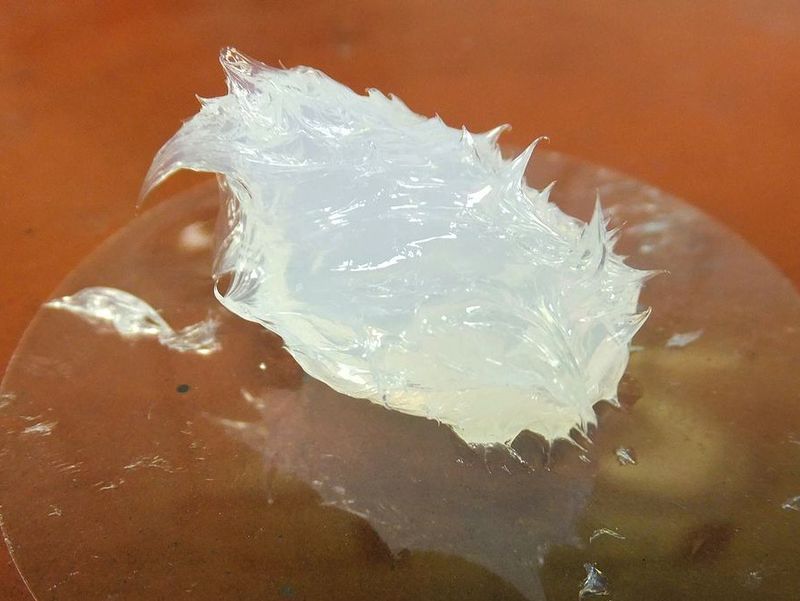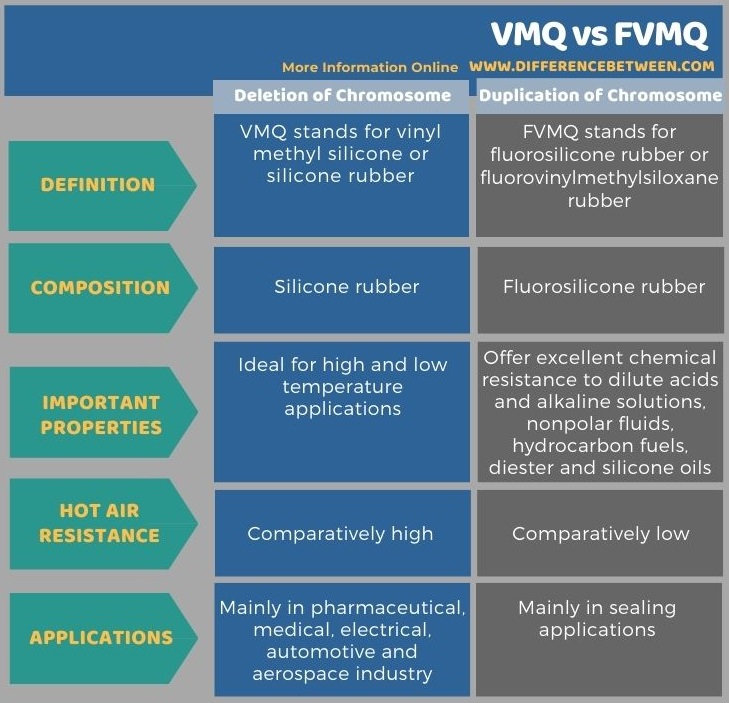The key difference between VMQ and FVMQ is that VMQ offers great hot air resistance compared to FVMQ.
The term VMQ stands for vinyl methyl silicone or silicone rubber. This type of material is ideal for high and low-temperature applications. The term FVMQ stands for fluorosilicone rubber. This type of material has many attributes of silicone.
CONTENTS
1. Overview and Key Difference
2. What is VMQ
3. What is FVMQ
4. Side by Side Comparison – VMQ vs FVMQ in Tabular Form
5. Summary
What is VMQ?
The term VMQ stands for vinyl methyl silicone or silicone rubber. These are elastomer compounds that are ideal for high and low-temperature applications. Moreover, these compounds have high heat and oxidative stability, along with outstanding low-temperature flexibility. VMQ materials are resistant to many chemicals, weathering, ozone and sunlight (UV). However, they are not resistant to superheated steam. Their physical properties are generally low but are usually retained at higher temperatures. Furthermore, VMQ materials have a poor gas permeability and low resistance to mineral oils and hydrocarbon solvents.
More importantly, VMQ rubber materials are extremely heat resistant. We can observe the typical working temperature range for this material as -60 to 250 Celsius degrees while some specific grades of VMQ can withstand up to 300 Celsius degrees. However, this material is affected by hot steam that is at or above 120 Celsius degrees. This hot steam can cause the hydrolysis of the substance as well as degradation.

Figure 01: Liquid Silicone Rubber
Comparatively, VMQ elastomers are rather expensive; thus, this material is only used when we need excellent resistance to chemicals, oxygen, weathering, and flexibility at very low temperatures. Therefore, VMQ materials are used mainly in the pharmaceutical industry, medical industry, electrical field, automotive industry, and aerospace industry. The most common applications of this substance are the production of surgical implants, wound dressings, mould making, wire, and cable insulations, gaskets, seals, and tubings.
What is FVMQ?
The term FVMQ stands for fluorosilicone rubber or fluorovinylmethylsiloxane rubber. This material has many attributes of silicone rubber material. E.g. FVMQ materials have similar mechanical and physical properties to that of VMQ rubbers, and they also offer an excellent chemical resistance towards dilute acids, alkaline solutions, nonpolar fluids such as petroleum oil, hydrocarbon fuels, diester and silicone oils. Furthermore, we can observe only a fair resistance towards polar fluids such as alcohols and poor resistance towards ketones, aldehydes, amines, and brake fluids. Moreover, this type of material has a lower hot air resistance compared to silicone rubbers.
More importantly, FVMQ substances have high heat and oxidative stability and outstanding low-temperature flexibility. This material is also resistant to heat, ozone, and sunlight. In addition, this material can offer a wide operational temperature range that is comparatively wider than most other fluorocarbon rubbers.
When considering the applications of FVMQ rubbers, the most common applications are in sealing applications where we need resistance towards hot fuels, oils, and diester based lubricants. Normally, the use of this material is limited to static applications due to poor abrasion resistance, relatively low tear strength and only fair flex cracking resistance.
What is the Difference Between VMQ and FVMQ?
The terms VMQ and FVMQ stand for two different types of silicone rubbers. VMQ stands for vinyl methyl silicone or silicone rubber, while FVMQ stands for fluorosilicone rubber or fluorovinylmethylsiloxane rubber. The key difference between VMQ and FVMQ is that VMQ offers great hot air resistance compared to FVMQ.
Below tabulation lists the important differences between VMQ and FVMQ.

Summary – VMQ vs FVMQ
The terms VMQ and FVMQ stand for two different types of silicone rubbers. The key difference between VMQ and FVMQ is that VMQ offers great hot air resistance compared to FVMQ.
Reference:
1. “VMQ – SILICONE RUBBER VINYL METHYL SILICONE.” Polymer Properties Database, Available here.
Image Courtesy:
1. “Liquid-silicon-rubber-crop” By By Gmhofmann (Own work) (CC BY-SA 3.0) via Commons Wikimedia
ncG1vNJzZmivp6x7pbXFn5yrnZ6YsqOx07CcnqZemLyue8OinZ%2Bdopq7pLGMm5ytr5Wau27CzKpkmqaUYrO3udBo